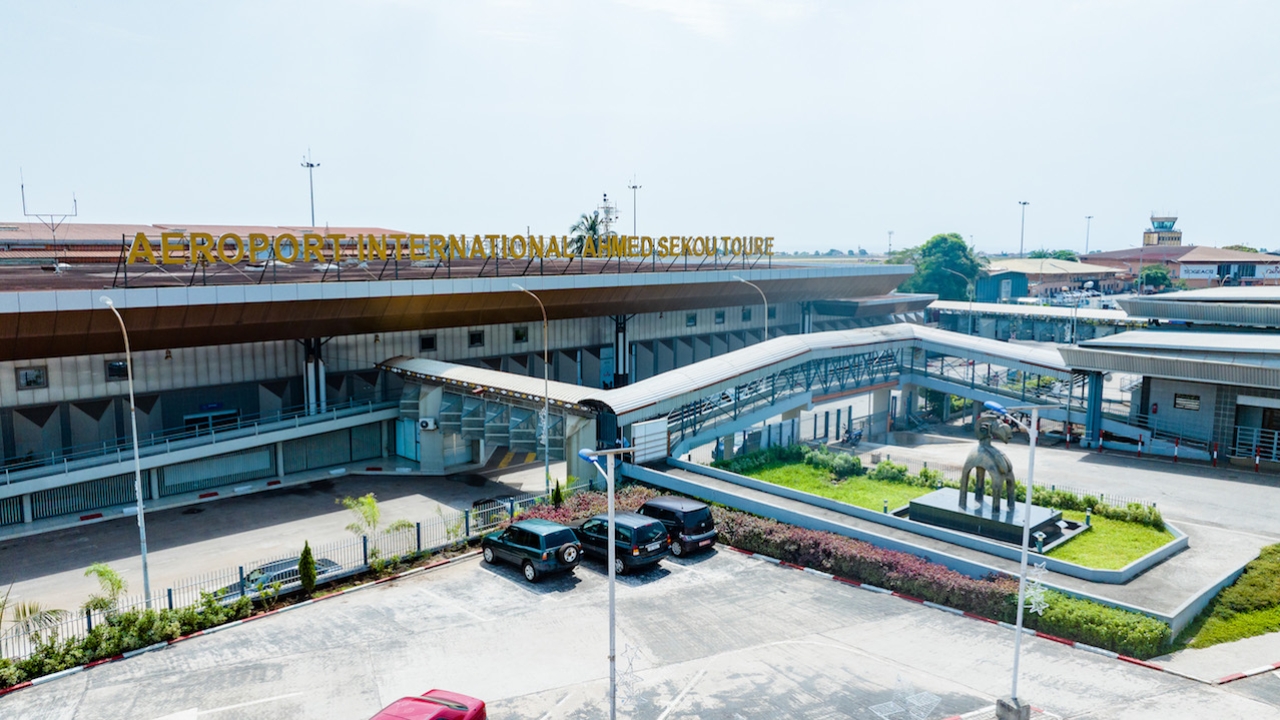Guinea banks on its touré de force...
As Guinea terminates its French partnership deal, managing director Namory Camara talks about how modernisation of Conakry’s Ahmed Sékou Touré Airport can now push ahead.

Ahmed Sékou Touré Airport undergoing change as it steps up development. Image SOGEAC
A bustling coastal city situated on West Africa’s Atlantic coastline, Conakry is the vibrant capital of Guinea. With an estimated population of 1.5 million, the city boasts a blend of traditional and modern influences with a vibrant cultural scene. It is also a hub of economic activity, housing government offices, financial institutions and a growing infrastructure, including Ahmed Sékou Touré Airport.
The primary gateway to the Republic of Guinea, the airport is located just 13km from the capital’s city centre and is now solely managed and operated by the Gbessia Airport Management Company (SOGEAC).
Namory Camara, has an aviation background spanning 20 years and was appointed the airport’s managing director two years ago. SOGEAC’s sole management of the airport is a recent development as it had previously been jointly managed with Groupe Aeroports de Paris (ADP).
The French operator had agreed in 2020 to take a 33% stake in the airport, providing technical and operational assistance, as well as to co-develop and finance its expansion and modernisation.
However, the Guinean state terminated the partnership at the beginning of 2022, with Camara noting authorities felt commitments that had been made to launch the airport’s expansion and modernisation had not been met. With Camara at the helm, progress has now been made and work on the airport’s modernisation, which is expected to cost in the region of €250-300 million, began in April 2023.
“To date, the work is progressing smoothly,” said Camara. He added that the Turkish contractor, Albayrak Group, “has deployed considerable financial, material, logistical and human resources over the last six months. Work on Phase One of the project – the construction of the general aviation building, which will serve as a terminal for private and national flights and as a temporary presidential pavilion has effectively begun. There is also the construction of the administrative buildings including the SOGEAC headquarters and the freight terminal, which are also well advanced and on schedule.”
In line with anticipated scheduled passenger growth at the airport, plans are also underway to construct a new passenger terminal covering an area of three hectares. Once Phase One is complete, Camara hopes to begin work on this new terminal in 2024, with the government seeking private funding through a public-private partnership arrangement. “We have seen steady growth in passenger traffic, with 630,000 passengers in 2022 and we expect to close 2023 with 750,000 passengers - the airport’s highest level of traffic on record. To meet this ongoing growth, plans for the new terminal, which currently has a capacity of 1.5 million passengers per annum, will ultimately enable us to accommodate up to three million passengers, which we expect to reach in the next 10 to 15 years,” he explained.
The overall expansion project will be completed in five phases and as well as the passenger terminal, general aviation building and presidential pavilion, the master plan includes a new control tower, improved surface access by road, a hotel, fire station and power plant, as well as new aircraft parking, improved passenger car parking facilities and a ground support equipment (GSE) maintenance hangar.
The wider adoption of new technologies to enhance the passenger experience is also integral to Camara’s vision for the airport. “We have to look at the airport as a business with passengers expecting the same service here in Guinea as they’re seeing elsewhere in the world,” he remarked.
Camara has already taken steps to improve car parking at the airport and has partnered with Kiwi to offer “one of the best parking systems in West Africa.” Visitors to the airport can now book and pay for parking using their mobile phones, which revealed Camara, has not only improved parking for passengers but also seen a 20-fold increase in non-aeronautical revenues from parking. The important thing here, he noted, is understanding your market. “Elsewhere in the world payment by credit card is widely accepted. However, in Africa the penetration of credit cards is relatively low, so enabling passengers to pay using their mobile is key, particularly when around 75% of the continent’s population is under the age of 25 and for whom the use of mobile technology is prolific.”
Underlining the need to see airports as a business, Camara noted that when he came on board, Ahmed Sékou Touré didn’t have much of a presence online with passengers having to call the airport to get information on flight schedules and airport operations. “Our collaboration with Kiwi has also enabled us to introduce an online flight booking system, enabling passengers to search for flight schedules from the airport, as well as book and pay for their travel.” Although, reiterating his point about the lack of credit card use, he also noted: “While we are seeing plenty of passengers looking online for flight information, they rarely book online.”
When it comes to digitalising and automating airport operations, Camara warns that airports across Africa need to be really considered when implementing these technologies. “Biometrics and automated services are a major investment for airports and the other stakeholders involved, including the government and immigration authorities. It comes back to understanding your customer base prior to making that investment. We are looking at doubling our check-in facilities from 14 to 30 kiosks as part of our modernisation project, but before doing so, we will survey our customers to see how much demand there is for self-service check-in and baggage kiosks,” he said.
“There is a saying, that Africans don’t travel, they move! We don’t travel light, it’s always with multiple suitcases so passengers prefer to use the counters manned by airport personnel.”
Acknowledging that one of the key aspects of the airport is its role in fostering economic development, Camara points to the country’s mining industry, which is worth an estimated US$20 billion, as being a key driver for boosting Guinea’s air traffic.
“Around 35% of our traffic currently originates in Europe, where we have a huge diaspora, but the Asian/ Chinese market is growing rapidly. We have mining companies from China, the US and the UAE all conducting business in Guinea and the airport needs to cater as a world-class facility for those business travellers. In addition, the investment in our cargo facilities also contributes to the efficient movement of goods, which will further bolster the country’s economic activities.”
Currently served by carriers including: Air France, Emirates, Brussels Airlines, Ethiopian Airlines, Asky, Royal Air Maroc, Air Senegal, Turkish Airlines and Air Cote D’Ivoire, Camara hopes to expand the airport’s existing destination network. Towards the end of 2023 Egis provided route development training for the team at Conakry.
Tailored specifically to incorporate relevant examples from the African market to foster a more insightful understanding, the plan is to extend the airport’s reach with new routes and enhanced frequencies of existing services. Camara also agreed that “the implementation of SAATM will of course be integral to boosting connectivity for the airport and the wider region. There is no other option if we want to develop air services in Africa.”
A crucial asset for Guinea and with a pivotal role to play in connecting the country to the global community, the expansion and modernisation of Ahmed Sékou Touré embodies the nation’s aspirations for growth, efficiency and connectivity on the international stage.
The challenge the airport will have beyond its current modernisation plans is its location so proximate to the city centre means there is limited growth beyond the three million passenger capacity.
But Camara is one step ahead.
Plans have already been mooted to build a new airport in Maferinyah (about 75km from Conakry), which could be developed into a fully-fledged airport city and which could replace the existing airport when it reaches capacity.
Watch this space!
Stay up to date
Subscribe to the free Times Aerospace newsletter and receive the latest content every week. We'll never share your email address.


